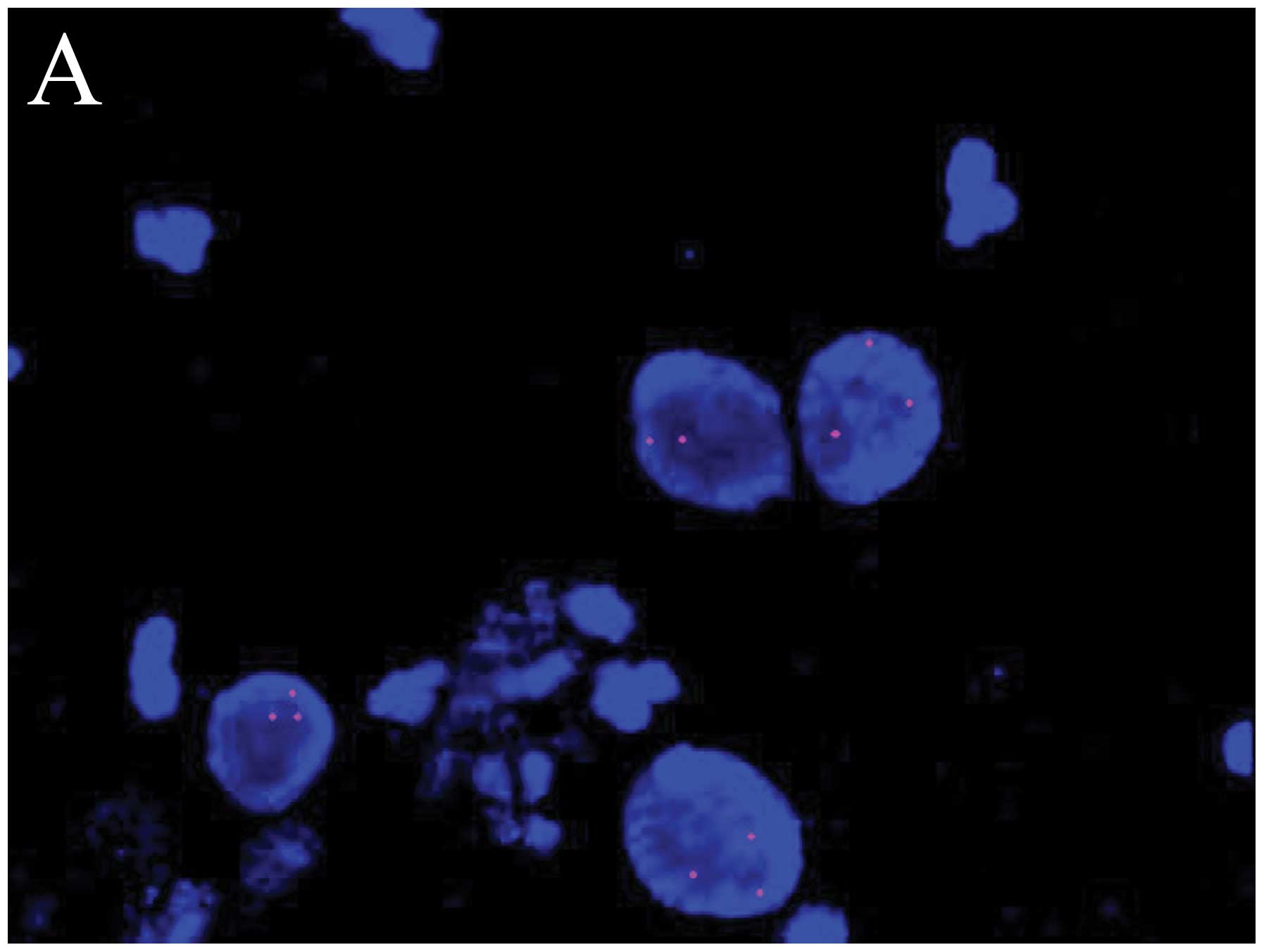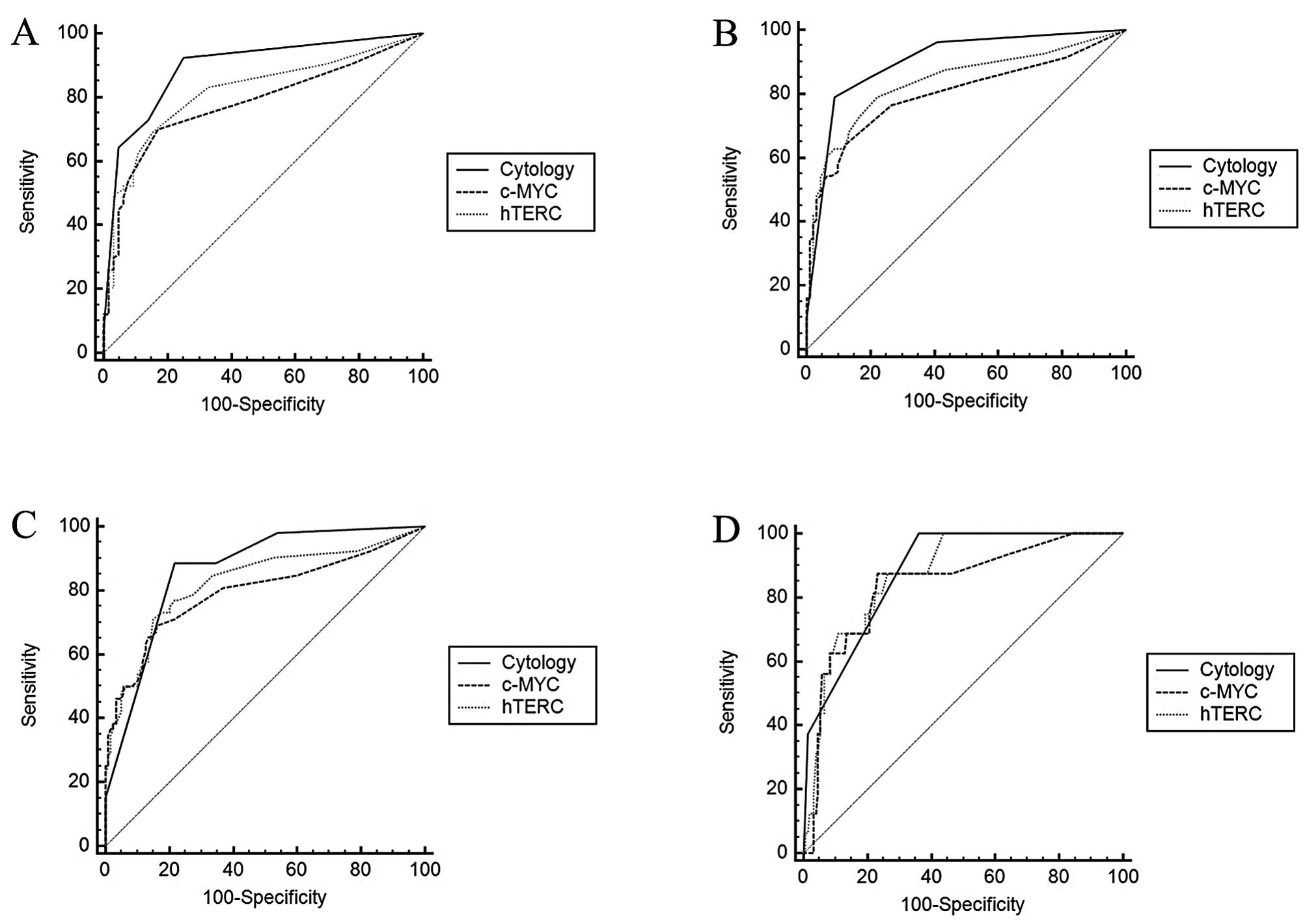|
1
|
Jemal A, Bray F, Center MM, Ferlay J, et
al: Global cancer statistics. CA Cancer J Clin. 61:69–90. 2011.
View Article : Google Scholar
|
|
2
|
Zhang A, Månér S, Betz R, Angström T,
Stendahl U, Bergman F, Zetterberg A and Wallin KL: Genetic
alterations in cervical carcinomas: frequent low-level
amplifications of oncogenes are associated with human
papillomavirus infection. Int J Cancer. 101:427–433. 2002.
View Article : Google Scholar
|
|
3
|
Wright TC Jr, Massad LS, Dunton CJ, et al:
2006 consensus guidelines for the management of women with abnormal
cervical screening tests. J Low Genit Tract Dis. 11:201–222. 2007.
View Article : Google Scholar
|
|
4
|
Christopherson WM, Parker JE, Mendez WM
and Lundin FE Jr: Cervix cancer death rates and mass cytologic
screening. Cancer. 26:808–811. 1970. View Article : Google Scholar : PubMed/NCBI
|
|
5
|
Quinn M, Babb P, Jones J and Allen E:
Effect of screening on incidence of and mortality from cancer of
cervix in England: evaluation based on routinely collected
statistics. BMJ. 318:904–908. 1999. View Article : Google Scholar : PubMed/NCBI
|
|
6
|
Pak SC, Martens M, Bekkers R, et al: Pap
smear screening history of women with squamous cell carcinoma and
adenocarcinoma of the cervix. Aust N Z J Obstet Gynaecol.
47:504–507. 2007. View Article : Google Scholar : PubMed/NCBI
|
|
7
|
Mählck CG, Jonsson H and Lenner P: Pap
smear screening and changes in cervical cancer mortality in Sweden.
Int J Gynaecol Obstet. 44:267–272. 1994.
|
|
8
|
Liu S, Semenciw R, Probert A and Mao Y:
Cervical cancer in Canada: changing patterns in incidence and
mortality. Int J Gynecol Cancer. 11:24–31. 2001. View Article : Google Scholar : PubMed/NCBI
|
|
9
|
Etzioni R, Urban N, Ramsey S, et al: The
case for early detection. Nat Rev Cancer. 3:243–252. 2003.
View Article : Google Scholar
|
|
10
|
Parkin DM, Bray F, Ferlay J and Pisani P:
Estimating the world cancer burden: Globocan 2000. Int J Cancer.
94:153–156. 2001. View
Article : Google Scholar : PubMed/NCBI
|
|
11
|
Cuzick J, Szarewski A, Cubie H, et al:
Management of women who test positive for high-risk types of human
papillomavirus: the HART study. Lancet. 362:1871–1876. 2003.
View Article : Google Scholar : PubMed/NCBI
|
|
12
|
Fahey MT, Irwig L and Macaskill P:
Meta-analysis of Pap test accuracy. Am J Epidemiol. 141:680–689.
1995.PubMed/NCBI
|
|
13
|
Koliopoulos G, Arbyn M, Martin-Hirsch P,
Kyrgiou M, Prendiville W and Paraskevaidis E: Diagnostic accuracy
of human papillomavirus testing in primary cervical screening: a
systematic review and meta-analysis of non-randomized studies.
Gynecol Oncol. 104:232–246. 2007. View Article : Google Scholar
|
|
14
|
Mayrand MH, Duarte-Franco E, Rodrigues I,
et al: Human papillomavirus DNA versus Papanicolaou screening tests
for cervical cancer. N Engl J Med. 357:1579–1588. 2007. View Article : Google Scholar : PubMed/NCBI
|
|
15
|
Nanda K, McCrory DC, Myers ER, et al:
Accuracy of the Papanicolaou test in screening for and follow-up of
cervical cytologic abnormalities: a systematic review. Ann Intern
Med. 132:810–819. 2000. View Article : Google Scholar : PubMed/NCBI
|
|
16
|
Guidos BJ and Selvaggi SM: Use of the Thin
Prep Pap Test in clinical practice. Diagn Cytopathol. 20:70–73.
1999. View Article : Google Scholar : PubMed/NCBI
|
|
17
|
Zur Hausen H: Papillomaviruses causing
cancer: evasion from hostcell control in early events in
carcinogenesis. J Natl Cancer Inst. 92:690–698. 2000.PubMed/NCBI
|
|
18
|
Duensing S and Münger K: Mechanisms of
genomic instability in human cancer: insights from studies with
human papillomavirus oncoproteins. Int J Cancer. 109:157–162. 2004.
View Article : Google Scholar : PubMed/NCBI
|
|
19
|
Lazo PA: The molecular genetics of
cervical carcinoma. Br J Cancer. 80:2008–2018. 1999. View Article : Google Scholar : PubMed/NCBI
|
|
20
|
Kurtycz D, Nuñez M, Arts T, Bauman C,
Harris C, Inhorn S and Meisner L: Use of fluorescent in-situ
hybridization to detect aneuploidy in cervical dysplasia. Diagn
Cytopathol. 15:46–51. 1996. View Article : Google Scholar : PubMed/NCBI
|
|
21
|
Heselmeyer K, Macville M, Schröck E,
Blegen H, Hellström AC, Shah K, Auer G and Ried T: Advanced-stage
cervical carcinomas are defined by a recurrent pattern of
chromosomal aberrations revealing high genetic instability and a
consistent gain of chromosome arm 3q. Genes Chromosomes Cancer.
19:233–240. 1997. View Article : Google Scholar
|
|
22
|
Thein A, Trková M, Fox M and Parrington J:
The application of comparative genomic hybridization to previously
karyotyped cervical cancer cell lines. Cancer Genet Cytogenet.
116:59–65. 2000. View Article : Google Scholar
|
|
23
|
Kirchhoff M, Rose H, Petersen BL, Maahr J,
Gerdes T, Lundsteen C, Bryndorf T, Kryger-Baggesen N, Christensen
L, Engelholm SA and Philip J: Comparative genomic hybridization
reveals a recurrent pattern of chromosomal aberrations in severe
dysplasia/carcinoma in situ of the cervix and in advanced-stage
cervical carcinoma. Genes Chromosomes Cancer. 24:144–150. 1999.
View Article : Google Scholar
|
|
24
|
Mullokandov MR, Kholodilov NG, Atkin NB,
Burk RD, Johnson AB and Klinger HP: Genomic alterations in cervical
carcinoma: losses of chromosome heterozygosity and human papilloma
virus tumor status. Cancer Res. 56:197–205. 1996.
|
|
25
|
Heselmeyer K, Schröck E, du Manoir S,
Blegen H, Shah K, Steinbeck R, Auer G and Ried T: Gain of
chromosome 3q defines the transition from severe dysplasia to
invasive carcinoma of the uterine cervix. Proc Natl Acad Sci USA.
93:479–484. 1996. View Article : Google Scholar : PubMed/NCBI
|
|
26
|
Kersemaekers AM, van de Vijver MJ, Kenter
GG and Fleuren GJ: Genetic alterations during the progression of
squamous cell carcinomas of the uterine cervix. Genes Chromosomes
Cancer. 26:346–354. 1999. View Article : Google Scholar : PubMed/NCBI
|
|
27
|
Dellas A, Torhorst J, Jiang F, Proffitt J,
Schultheiss E, Holzgreve W, Sauter G, Mihatsch MJ and Moch H:
Prognostic value of genomic alterations in invasive cervical
squamous cell carcinoma of clinical stage IB detected by
comparative genetic hybridization. Cancer Res. 59:3475–3479.
1999.
|
|
28
|
Hidalgo A, Schewe C, Petersen S, Salcedo
M, Gariglio P, Schlüns K, Dietel M and Petersen I: Human papilloma
virus status and chromosomal imbalances in primary cervical
carcinomas and tumor cell lines. Eur J Cancer. 36:542–548. 2000.
View Article : Google Scholar : PubMed/NCBI
|
|
29
|
Todd R and Wong DT: Oncogenes. Anticancer
Res. 19:4729–4746. 1999.
|
|
30
|
Bishop JM: Molecular themes in
oncogenesis. Cell. 64:235–248. 1991. View Article : Google Scholar : PubMed/NCBI
|
|
31
|
Adhikary S and Eilers M: Transcriptional
regulation and transformation by Myc proteins. Nat Rev Mol Cell
Biol. 6:635–645. 2005. View
Article : Google Scholar : PubMed/NCBI
|
|
32
|
Couturier J, Sastre-Garau X,
Schneider-Maunoury S, Labib A and Orth G: Integration of
papillomavirus DNA near myc genes in genital carcinomas and its
consequences for proto-oncogene expression. J Virol. 65:4534–4538.
1991.PubMed/NCBI
|
|
33
|
Sastre-Garau X, Favre M, Couturier J and
Orth G: Distinct patterns of alteration of myc genes associated
with integration of human papillomavirus type 16 or type 45 DNA in
two genital tumors. J Gen Virol. 81:1983–1993. 2000.PubMed/NCBI
|
|
34
|
Umayahara K, Hirai Y, Sugiyama Y, et al:
Genetic alterations during the progression of early cervical
neoplasm. Proc Amer Assoc Cancer Res. 46:57432005.
|
|
35
|
Heselmeyer-Haddad K, Sommerfeld K, White
NM, et al: Genomic amplification of the human telomerase gene
(TERC) in pap smears predicts the development of cervical cancer.
Am J Pathol. 166:1229–1238. 2005. View Article : Google Scholar : PubMed/NCBI
|
|
36
|
Sokolova I, Algeciras-Schimnich A, Song M,
et al: Chromosomal biomarkers for detection of human papillomavirus
associated genomic instability in epithelial cells of cervical
cytology specimens. J Mol Diagn. 9:604–611. 2007. View Article : Google Scholar
|
|
37
|
Matthews CP, Shera KA and McDougall JK:
Genomic changes and HPV type in cervical carcinoma. Proc Soc Exp
Biol Med. 223:316–321. 2000. View Article : Google Scholar : PubMed/NCBI
|
|
38
|
Widschwendter A, Ivarsson L, Blassnig A,
et al: CDH1 and CDH13 methylation in serum is an independent
prognostic marker in cervical cancer patients. Int J Cancer.
109:163–166. 2004. View Article : Google Scholar : PubMed/NCBI
|
|
39
|
Apostolidou S, Hadwin R, Burnell M, et al:
DNA methylation analysis in liquid-based cytology for cervical
cancer screening. Int J Cancer. 125:2995–3002. 2009. View Article : Google Scholar : PubMed/NCBI
|
|
40
|
Rosa MI, Medeiros LR, Bozzetti MC, et al:
Accuracy of telomerase in cervical lesions: a systematic review.
Int J Gynecol Cancer. 17:1205–1214. 2007. View Article : Google Scholar : PubMed/NCBI
|
|
41
|
Li Y, Ye F, Lü WG, et al: Detection of
human telomerase RNA gene in cervical cancer and precancerous
lesions: comparison with cytological and human papillomavirus DNA
test findings. Int J Gynecol Cancer. 20:631–637. 2010. View Article : Google Scholar : PubMed/NCBI
|
|
42
|
Walboomers JM, Jacobs MV, Manos MM, et al:
Human papillomavirus is a necessary cause of invasive cervical
cancer worldwide. J Pathol. 189:12–19. 1999. View Article : Google Scholar : PubMed/NCBI
|
















